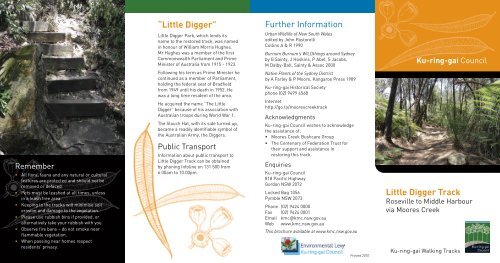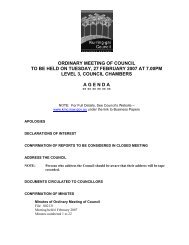Little Digger Track - Ku-ring-gai Council
Little Digger Track - Ku-ring-gai Council
Little Digger Track - Ku-ring-gai Council
You also want an ePaper? Increase the reach of your titles
YUMPU automatically turns print PDFs into web optimized ePapers that Google loves.
“<strong>Little</strong> <strong>Digger</strong>”<br />
Further Information<br />
<strong>Little</strong> <strong>Digger</strong> Park, which lends its<br />
name to the restored track, was named<br />
in honour of William Morris Hughes.<br />
Mr Hughes was a member of the first<br />
Commonwealth Parliament and Prime<br />
Minister of Australia from 1915 - 1923.<br />
Urban Wildlife of New South Wales<br />
edited by John Pastorelli<br />
Collins A & R 1990<br />
Burnum Burnum’s WILDthings around Sydney<br />
by G Sainty, J Hoskins, P Abel, S Jacobs,<br />
M Dalby-Ball, Sainty & Assoc 2000<br />
<strong>Ku</strong>-<strong>ring</strong>-<strong>gai</strong> <strong>Council</strong><br />
Remember<br />
• All flora, fauna and any natural or cultural<br />
features are protected and should not be<br />
removed or defaced.<br />
• Pets must be leashed at all times, unless<br />
in a leash free area.<br />
• Keeping to the tracks will minimise soil<br />
erosion and damage to the vegetation.<br />
• Please use rubbish bins if provided, or<br />
alternatively take your rubbish with you.<br />
• Observe fire bans – do not smoke near<br />
flammable vegetation.<br />
• When passing near homes respect<br />
residents’ privacy.<br />
Following his term as Prime Minister he<br />
continued as a member of Parliament,<br />
holding the federal seat of Bradfield<br />
from 1949 until his death in 1952. He<br />
was a long time resident of the area.<br />
He acquired the name “The <strong>Little</strong><br />
<strong>Digger</strong>” because of his association with<br />
Australian troops du<strong>ring</strong> World War 1.<br />
The Slouch Hat, with its side turned up,<br />
became a readily identifiable symbol of<br />
the Australian Army, the <strong>Digger</strong>s.<br />
Public Transport<br />
Information about public transport to<br />
<strong>Little</strong> <strong>Digger</strong> <strong>Track</strong> can be obtained<br />
by phoning Infoline on 131 500 from<br />
6.00am to 10.00pm.<br />
Native Plants of the Sydney District<br />
by A Farley & P Moore, Kangaroo Press 1989<br />
<strong>Ku</strong>-<strong>ring</strong>-<strong>gai</strong> Historical Society<br />
phone (02) 9499 4568<br />
Internet<br />
http://go.to/moorescreektrack<br />
Acknowledgments<br />
<strong>Ku</strong>-<strong>ring</strong>-<strong>gai</strong> <strong>Council</strong> wishes to acknowledge<br />
the assistance of:<br />
• Moores Creek Bushcare Group<br />
• The Centenary of Federation Trust for<br />
their support and assistance in<br />
resto<strong>ring</strong> this track.<br />
Enquiries<br />
<strong>Ku</strong>-<strong>ring</strong>-<strong>gai</strong> <strong>Council</strong><br />
818 Pacific Highway<br />
Gordon NSW 2072<br />
Locked Bag 1056<br />
Pymble NSW 2073<br />
Phone (02) 9424 0000<br />
Fax (02) 9424 0001<br />
Email kmc@kmc.nsw.gov.au<br />
Web www.kmc.nsw.gov.au<br />
This brochure available at www.kmc.nsw.gov.au<br />
Printed 2010<br />
<strong>Little</strong> <strong>Digger</strong> <strong>Track</strong><br />
Roseville to Middle Harbour<br />
via Moores Creek<br />
<strong>Ku</strong>-<strong>ring</strong>-<strong>gai</strong> Walking <strong>Track</strong>s
<strong>Little</strong> <strong>Digger</strong> <strong>Track</strong><br />
<strong>Little</strong> <strong>Digger</strong> <strong>Track</strong> is a one kilometre walk<br />
that takes approximately 40 minutes to<br />
complete. The track starts under the old oak<br />
tree at the corner of Roseville Avenue and<br />
Amarna Parade, Roseville, opposite the <strong>Little</strong><br />
<strong>Digger</strong> Park.<br />
The track follows Moores Creek, skirting the<br />
Roseville Golf Course, then descends into<br />
the sandstone gully until it joins with the<br />
Two Creeks <strong>Track</strong> which takes you to Middle<br />
Harbour.<br />
Sections of the track were originally built<br />
to provide access to Roseville Baths in the<br />
1920’s. After the closure of the baths in<br />
1969 the track fell into disuse and became<br />
overgrown with vegetation.<br />
Thanks to funding from the Federal<br />
Government through the Centenary of<br />
Federation Trust, and support from the local<br />
community, the track has been restored<br />
and once more provides access to Middle<br />
Harbour.<br />
Features of the track include waterfalls,<br />
rock pools and caves, remnants of rainforest<br />
vegetation, mighty Sydney Red Gums<br />
(Angophora costata), She Oaks (Casuarina<br />
glauca) and many types of ferns.<br />
Points of Interest<br />
1 Roseville Golf Course was used by the<br />
Australian Military du<strong>ring</strong> World War 1 as<br />
a training camp for Army Engineers. The<br />
engineers were trained in the construction<br />
of trenches and timber bridges. Much of the<br />
timber used for construction was obtained<br />
from the local area.<br />
2 <strong>Little</strong> Falls was aptly named due to the size of<br />
the water fall.<br />
3 Babbage Falls was named after Eden<br />
Herschel Babbage who was a <strong>Ku</strong>-<strong>ring</strong>-<strong>gai</strong><br />
<strong>Council</strong> alderman. Mr Babbage was also well<br />
known for his altruistic regard for his fellow<br />
citizens and his dedicated efforts for the<br />
establishment of Roseville Park.<br />
4 Sandstone Steps are thought to have been<br />
constructed in the 1930’s by works gangs<br />
du<strong>ring</strong> the Great Depression as part of the<br />
original walking track to the Roseville Baths.<br />
5 Carlyle Falls was possibly names after the<br />
English author and philosopher Thomas<br />
Carlyle.<br />
Map<br />
4<br />
3<br />
2<br />
5<br />
The varied habitat is home to a large number<br />
of Australian native animals including the<br />
rare and threatened Powerful Owl (Ninox<br />
strenua). Walking quietly you may see the<br />
Eastern Water dragon (Physignathus lesueurii)<br />
and hear the calls of frogs. Look up into the<br />
brushy shrubs and you will see the homes<br />
(dreys) of the shy <strong>ring</strong>tail possums (Pseudocheirus<br />
peregrinus).<br />
NORTH<br />
0 300m<br />
Scale<br />
1<br />
Photos: D. Wilks<br />
Water Gum

















